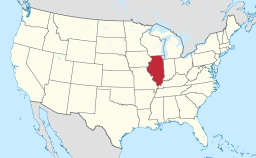LaGrange, Illinois
| La Grange, Illinois | |
| Village | |
|
La Grange Village Hall
|
|
| Official name: Village of La Grange, Illinois | |
| Country | United States |
|---|---|
| State | Illinois |
| County | Cook |
| Coordinates | 41°48′29″N 87°52′24″W / 41.80806°N 87.87333°WCoordinates: 41°48′29″N 87°52′24″W / 41.80806°N 87.87333°W |
| Area | 2.52 sq mi (7 km2) |
| - land | 2.52 sq mi (7 km2) |
| - water | 0.00 sq mi (0 km2) |
| Population | 15,550 (2010) |
| Density | 6,170.6/sq mi (2,382/km2) |
| Timezone | CST (UTC-6) |
| - summer (DST) | CDT (UTC-5) |
| Postal code | 60525 |
| Area code | 708 |
|
Location in Cook County and the state of Illinois.
|
|
|
Location of Illinois in the United States
|
|
|
Website: www |
|
La Grange, a suburb of Chicago, is a village in Cook County, in the U.S. state of Illinois. The population was 15,550 at the 2010 census.
The area around La Grange was first settled in the 1830s, when Chicago residents moved out to the west due to the rapid population increase in the city in the decade since its incorporation. The first settler, Robert Leitch, came to the area in 1830, seven years before the City of Chicago was incorporated. La Grange's location, at approximately 13 miles (21 km) from the Chicago Loop, is not considered far from the city by today's standards, but in that time the residents enjoyed the peace of rural life without much communication with urban residents.
The village was officially incorporated on June 11, 1879. It was founded by Franklin Dwight Cossitt, who was born in Granby, Connecticut, and raised in Tennessee, and moved to Chicago in 1862 where he built a successful wholesale grocery business.
In 1870, Cossitt purchased several hundred acres of farmland in Lyons Township, along the Chicago-Dixon Road, known today as Ogden Avenue (U.S. Highway 34). Ogden Avenue, on the site of a defunct Native American trail, was also referred to as the "Old Plank Road". Planks were often stolen by settlers to be used as building material, which made traveling very bumpy. When the Chicago, Burlington & Quincy Railroad came to town, La Grange was a milk stop called Hazel Glen. A few miles to the south, through present-day Willow Springs, the Illinois and Michigan Canal had emerged as a major shipping corridor, connecting Chicago and the Great Lakes with the Illinois and Mississippi rivers.
...
Wikipedia



